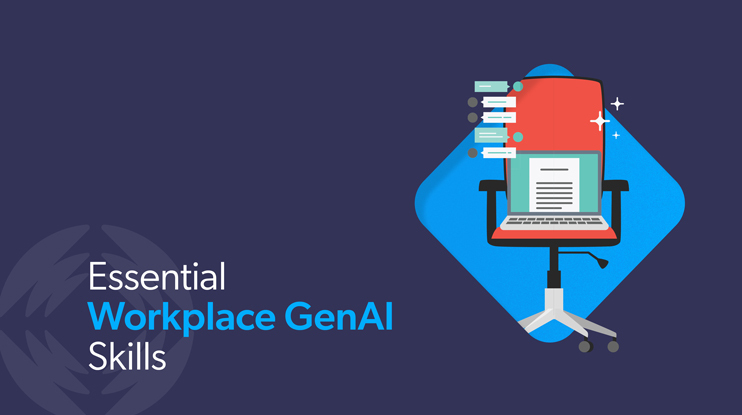The hottest topic in business today is artificial intelligence, specifically, generative AI, a form of artificial intelligence that is capable of generating text, images, videos, audio, data, analyses, etc. based on prompts at a larger scale than ever before.
And as it becomes increasingly prevalent in the workplace, the fear that it will replace employees remains — but another emotion pops its head up, too: excitement. Coveo’s recent GenAI Report uncovered that 86% want to use GenAI at work. Another 52% see GenAI as a great tool to find more relevant information. And another 56% estimated that it could save them at least an hour a day.
After all, both human and artificial intelligence have the potential to profoundly reshape the way we work, complementing and enhancing employee capabilities. As a matter of fact, AI can take on those repetitive and menial tasks that waste an employee’s time, freeing them to focus on more complex, creative, and value-add work.
How Is Generative AI Used in the Workplace?
There are a lot of valuable use cases for generative AI in the workplace today. Automation is a big part of that, obviously. Here are just a few examples of how it’s used.
- Content generation: Kick-start the creative process by generating first drafts of articles, reports, product descriptions, and marketing materials, to get started faster and save time.
- Design and creativity: Assist designers in generating designs, layouts, and prototypes, as well as exploring new ideas, generating variations, and optimizing designs based on specific criteria.
- Natural language processing (NLP): Pair NLP models with generative AI for text summarization, translation, localization, sentiment analysis, and chatbots. These use cases help businesses streamline customer support, analyze large volumes of text data, and enable customers to search with terms they’re more familiar with (and still get the right results).
- Data augmentation: Generate synthetic data for training machine learning models. This helps address data scarcity issues and improves the overall performance and generalization of AI models.
- Virtual assistants: Generative AI powers virtual assistants like Siri, Alexa, and Google Assistant, enabling users to interact with devices and access information using natural language commands.
- Voice recognition: Voice recognition technology uses generative AI to transcribe speech into text and vice versa, enhancing accessibility by enabling hands-free interaction and facilitating communication for individuals with physical or visual impairments.
- Image and video creation: Generative AI models can generate realistic images and videos based on specific inputs and details, making content creation easier than ever before.
- Personalization and recommendations: Generative AI algorithms analyze user behavior and preferences to generate personalized recommendations for products, services, content, and advertisements.
How Do We Prepare Employees?
Here’s an important question to consider as we think about augmenting employee capabilities with artificial ones:
How do we prepare employees for the new work environment that lies ahead? How do we prepare them to work with this new technology?
The answers lie in these solutions.
- Hiring employees proficient in:
- Data science
- Machine learning and other algorithms
- Analytics (including business analytics)
- Upskilling or reskilling current employees on:
- Technical aspects of the work
- Non-technical aspects of the work
- Coaching employees to:
- Work together with other departments
- Share data and insights across the organization
- Learn from one another
- Training employees to:
- Design and deliver the new experience
- Work together with AI/automation
I’ll go into more detail about the skills and training needed, but it’s important to note that, because data really is the foundation of a successful AI strategy, it needs to be accessible and shared. It also needs to be contextually-relevant to the specific work being done.
Upskilling or Reskilling Employees
In order to execute a successful AI strategy that improves both employee and customer experiences, it is important that employees have the right skills and training – both technical (hard) and non-technical (soft) – to do just that.
Some of the hard skills that will be required include the following. Keep in mind that the depth of the necessary domain knowledge really depends on each employee’s specific role in the organization and in the strategy.
- Data literacy: Since generative AI is rooted in data, employees must be skilled in data collection, cleaning, visualization, and analysis. They need to understand how to interpret data patterns and AI-generated insights to derive meaningful conclusions and make informed decisions, identify biases, and select appropriate datasets for training generative models.
- AI prompting: To get the most out of generative AI, employees must be skilled in providing the optimal input or prompt, e.g., words, phrases, sentence structure, etc., to a model to generate the desired outputs. In other words, they need to learn to speak AI.
- Verification: To ensure accuracy and provide a reality check, reliability, and integrity of AI-generated outputs and processes, employees must be able to critically evaluate generative AI responses for errors, biases, inconsistencies, and misleading information.
- Human-machine collaboration: Employees must know how to work alongside AI systems and collaborate effectively with them. It will be important to know the strengths and weaknesses of AI, be able to adapt to new technologies, and find ways to optimize human-machine interactions. “Human in the loop” is what this skill or concept is often referred to.
- Cybersecurity awareness: With the increased use of AI comes the potential for cybersecurity threats and vulnerabilities. Employees should be knowledgeable about cybersecurity best practices and understand how to safeguard AI systems and data from potential breaches.
- AI training: In order for employees to be proficient in using generative AI and to ensure the best outcomes/outputs, provide basic training on machine learning, deep learning, and specific generative AI strategies. Helping employees understand the underlying principles and implementation details will empower them to use these tools more effectively.
The technical skills provide a solid foundation for using generative AI in the workplace, but employees must also be equipped with some basic soft skills to provide context and to ensure the work is done in the right vein. Some of those skills are listed below.
- Critical thinking and problem solving: Employees will need to critically evaluate AI-generated outputs, understand their limitations, and identify potential errors or biases. They will also need to find ways to troubleshoot these technologies as they evolve and shift.
- Creativity and innovation: While AI can generate content and solutions, humans still excel in creative thinking and innovation. A draft generated by AI will likely never be acceptable as the final graphic for an external marketing campaign. Employees who can ideate, innovate, and think outside the box will remain indispensable.
- Adaptability and learning agility: Employees will need to evolve as the field of artificial intelligence evolves. They must be adaptable and willing to continuously learn new skills and tools to keep pace with changes in the workplace.
- Ethical awareness and judgment: As AI systems increasingly impact decision-making processes, employees must possess a strong sense of ethics and responsibility to ensure that AI is used ethically and responsibly, without perpetuating bias or discrimination.
- Collaboration and interpersonal skills: Generative AI often requires collaboration with colleagues specializing in data science, computer science, and domain-specific expertise. Employees who can effectively communicate and collaborate with experts from diverse backgrounds will be valued.
- Emotional intelligence and empathy: Despite technological advancements, human interaction and empathy remain essential in the workplace. Employees who can empathize with colleagues, clients, and customers will continue to play crucial roles in fostering positive relationships and driving success.
By honing these skills, employees can position themselves to thrive in a workplace where generative AI is increasingly prevalent — contributing meaningfully to innovation, decision-making, and collaboration.
AI and the Employee Experience
It seems like a lot to put on employees, but there’s no way around it. If you’re not already using generative AI tools in your business, you’re behind your competition. Using AI enhances both employee and customer experiences.
How will employees benefit from investing in these skills and training? How does upskilling and using AI in their day-to-day impact the employee experience?
Here are some of the positive impacts:
- Automation of repetitive tasks: As mentioned before, generative AI can automate repetitive and mundane tasks, allowing employees to focus on more strategic, impactful and value-adding activities.
- Enhanced creativity and innovation: Generative AI can inspire creativity and innovation by providing employees with new tools and capabilities to generate ideas at a much larger scale, expanding their output. This helps them explore possibilities and experiment with different concepts.
- Augmented decision-making: Generative AI can assist employees in decision-making by analyzing large data sets, generating insights, and providing recommendations based on predefined criteria. This helps them make informed decisions more quickly and effectively.
- Personalization: Customers aren’t the only ones expecting personalization across their digital experiences. Generative AI personalizes the employee experience by tailoring content, recommendations, and interactions based on their individual preferences, behaviors, and departments.
- Continuous learning and development: As you can see from the skills noted above, generative AI presents a powerful opportunity for employees to educate themselves within the systems they already use – allowing them to acquire new skills, explore emerging technologies, and adapt to changing work environments. Empowering and upskilling employees also contributes to their professional growth further down the line.
Ultimately, generative AI can influence organizational culture and dynamics by reshaping how the way we work, how decisions are made, and how employees interact with this new technology and with each other.
Organizations need to foster a culture of trust, openness, and collaboration to harness the full potential of generative AI. This must be balanced with addressing concerns surrounding this new technology to ensure that employees feel valued, empowered, and supported in the workplace.
In Closing…
The rise of generative AI signals a transformative era in the workplace, reshaping the landscape of skills and competencies required for success. As more organizations adopt generative AI technologies, employees must equip themselves with a diverse array of skills to navigate and harness the potential of these powerful tools effectively.
The employee experience is profoundly influenced by the integration of generative AI, offering opportunities for automation, innovation, and personalized engagement, while also posing challenges related to privacy, bias, and ethical considerations.
As we navigate this dynamic landscape, fostering a culture of continuous learning, collaboration, and ethical responsibility is paramount. By investing in upskilling and reskilling initiatives and cultivating a supportive work environment, organizations can empower their employees to thrive in the era of generative AI, driving innovation, productivity, and sustainable growth in the digital age.


